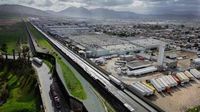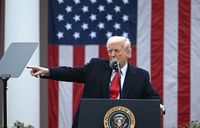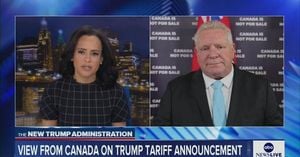On Wednesday, April 2, 2025, President Donald Trump announced a significant shift in U.S. trade policy, declaring what he termed "economic independence" for the United States. This declaration came alongside the introduction of a series of new tariffs aimed at various foreign nations, raising concerns among American businesses and economic analysts about the potential repercussions for the U.S. economy.
The new tariffs will impose a base rate of 10% on all foreign imports, with additional tariffs ranging from 11% to 50% for approximately 70 countries deemed the worst offenders. Notably, the European Union will face a hefty 20% tariff, while countries like Japan and China will see rates of 24% and 34%, respectively. The tariffs are set to take effect on April 5, 2025, for the base rate and April 9, 2025, for the higher rates.
Trump's announcement was made in the White House Rose Garden, where he expressed his intention to combat what he characterized as unfair trade practices by other countries. He stated, "It’s our turn to get rich," promising to end the "abuses" faced by American workers and to bring manufacturing jobs back to the United States. This rhetoric aligns with his longstanding "America First" agenda, which aims to prioritize U.S. interests in international trade.
However, the implications of these tariffs are already raising alarms among various sectors. The Consumer Technology Association (CTA) has warned that these tariffs represent a massive tax increase for Americans, likely accelerating inflation and jeopardizing jobs. Gary Shapiro, the CTA's president, cautioned that the tariffs could lead to a recession, as American importers would likely pass on increased costs to consumers.
Neil Bradley, from the U.S. Chamber of Commerce, echoed these concerns, stating that businesses across the country are reporting that these tariffs will act as a tax increase that will ultimately harm consumers and weaken the economy. He noted, "Many industry groups already operate on thin margins. The additional costs associated with these tariffs threaten investment, employment, and supply chains, undermining the U.S. ability to compete internationally."
In the restaurant industry, the impact of these tariffs could be particularly severe. Michelle Korsmo, the CEO of the American Restaurant Association, explained that many restaurants are struggling to stay open due to rising costs. She indicated that while some establishments try to source ingredients domestically, it is often impossible for American farmers to meet the high demand from consumers.
Interestingly, Canada and Mexico appear to be largely spared from these new tariffs, despite Trump’s previous criticisms of both countries. Canada, in particular, has been a frequent target of Trump’s rhetoric, especially regarding dairy tariffs that he claims can reach as high as 300%. However, this figure only applies under specific conditions, such as exceeding quotas.
The absence of Canada from the list of countries facing reciprocal tariffs has raised eyebrows, especially as Trump had previously attacked the nation during his speech. The tariffs are designed to respond to the barriers imposed by other countries on U.S. imports, with Trump using a large visual chart to illustrate the tariffs imposed on American goods by various nations.
Among the countries listed for reciprocal tariffs, China stands out with an average tariff of 34%, which is significantly lower than the estimated 67% tariff equivalent that the U.S. government claims China imposes on American exporters. This discrepancy has led to criticism from various quarters, including Canadian Prime Minister Mark Carney, who stated, "President Trump has just announced a series of measures that will fundamentally change the international trade system." He emphasized that Canada would respond to these tariffs with retaliatory measures targeting $60 billion worth of American imports.
Richard Ouellet, a professor of international commercial law, questioned the rationale behind the U.S. government's calculations for these tariffs, calling them "grossly exaggerated" and suggesting that they could push Asian countries closer to China as they seek to counteract U.S. trade policies.
The overall atmosphere of uncertainty stemming from these tariff announcements has already begun to affect consumer confidence and investment decisions across the board. Businesses and investors are left grappling with the unpredictability of U.S. trade policy, which has shifted rapidly in recent weeks.
Trump’s administration has not provided clarity on how these tariffs will be enforced or the criteria for determining which countries are classified as offenders. Critics argue that this lack of transparency only adds to the anxiety felt by consumers and businesses alike.
As the situation develops, many are left wondering how these tariffs will ultimately affect the U.S. economy. With warnings of potential job losses and increased consumer prices, the ramifications of Trump’s trade policies may extend far beyond the immediate effects of the tariffs.
In summary, while the Trump administration touts these tariffs as a means to protect American interests and promote economic independence, the potential fallout could lead to significant economic challenges. As various sectors brace themselves for the impact, the question remains: will these tariffs achieve their intended goals, or will they further complicate the already intricate landscape of international trade?







